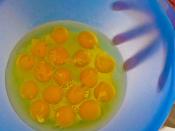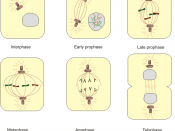An essay describing the processes that make up mitosis (cell replication). Very good.
The process of Mitosis
---------------------------------------
Mitosis is the term used to describe cell division for replication. The product at the end of mitosis is two daughter cells both genetically identical to the original (parent) cell. This process (mitosis) is used for growth and repair within an organism (and also for asexual reproduction).
There are five main stages to mitosis, called Interphase, Prophase, Metaphase, Anaphase and Telophase. Although the process has been divided up into these stages the process of mitosis is actually continuous.
Interphase
---------------------------------------
In this, the first stage the cell will look just like any other 'normal' cell although this is far from the case because very much is actually happening. All cell organelles are being produced in quantity and the chromosomes - DNA molecules are being copied exactly. The two identical copies of DNA are called a 'pair of chromatids' and they are linked together by an item called a 'chromomere'.
During this stage a store of ATP is also built up.
[Best put a labelled diagram of a cell during Interphase here.]
Prophase
---------------------------------------
In this second stage changes to the cell become visible. The chromosomes condense, coiling up to about 5% of their original length, now clearly visible when a stain is added. The centrioles move to the opposite poles of the cell and small microtubules around the centrioles become visible (called 'Asters'). The nuclear membranes and nucleolus disintegrate after passing their nucleic acids to certain pairs of chromatids. Now a spindle forms, this is also made out of microtubules.
[A labelled diagram of the end of the Prophase stage of a cell here would be great.]
Metaphase
---------------------------------------
During this stage the chromosomes move towards the equator of...


